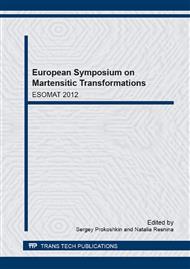[1]
Gschneidner K.A. Jr., V.K. Pecharsky, Thirty years of near room temperature magnetic cooling: Where we are today and future prospects, Int. J. Refrig. 31 (2008) 945.
DOI: 10.1016/j.ijrefrig.2008.01.004
Google Scholar
[2]
Bingfeng Yu, Min Liu, Peter W Egolf, Andrej Kitanovski, A review of magnetic refrigerator and heat pump prototypes built before the year 2010, Int. J. Refrig. 33 (2010) 1029.
DOI: 10.1016/j.ijrefrig.2010.04.002
Google Scholar
[3]
P. M. Shan, J. G. Bohnet, Jeffrey E. Shield, D. Schmitter, G. Shelburne and D. Leslie-Pelecky, Magnetic behavior of melt-spun gadolinium, Phys. Rev. B. 77 (2008) 184415.
DOI: 10.1103/physrevb.77.184415
Google Scholar
[4]
G.V. Brown, Magnetic heat pumping near room temperature, J. Appl. Phys. 47 (8) (1976) 3673-3680.
Google Scholar
[5]
M.D. Kuz'min, Factors limiting the operation frequency of magnetic refrigerators, Appl. Phys. Lett. 90 (2007) 251916.
DOI: 10.1063/1.2750540
Google Scholar
[6]
L.D. Kirol and M.W. Dacus, Rotary recuperative magnetic heat pump, Adv. Cryog. Eng. 33 (1988) 757.
DOI: 10.1007/978-1-4613-9874-5_92
Google Scholar
[7]
M. -A. Richard, A.M. Rowe and R. Chanine, Magnetic refrigeration: Single and multimaterial active magnetic regenerator experiments, J. Appl. Phys., 95 (2004) 2146.
DOI: 10.1063/1.1643200
Google Scholar
[8]
C. Zimm, A. Jastrab, A. Sternberg, V.K. Pecharsky, K.A. Gschneidner, Jr., M. Osborne and I. Anderson, Adv. Cryog. Eng., 43 (1998) 1759.
DOI: 10.1007/978-1-4757-9047-4_222
Google Scholar
[9]
T. Okamura, K. Yamada, N. Hirano and S. Nagaya, Performance of a room-temperature rotary magnetic refrigerator, Int. J. Refrigeration, 29 (2006) 1327.
DOI: 10.1016/j.ijrefrig.2006.07.020
Google Scholar
[10]
C. Zimm, A. Boeder, J. Chell, A. Sternberg, A. Fujita, S. Fujieda and K. Fukamichi, Design and performance of a permanent-magnet rotary refrigerator, Int. J. Refrigeration, 29 (2006) 1302.
DOI: 10.1016/j.ijrefrig.2006.07.014
Google Scholar
[11]
A. Rowe and A. Tura, Experimental Investigation of a Three-material Layered AMR, Int. J. Refrig. 29 (2006) 1286.
Google Scholar
[12]
Aliev A.M., Batdalov A.B., Kalitka V.S., Magnetocaloric Properties of Manganites in Alternating Magnetic Fields, JETP Letters. 90 (10) (2010) 663-666.
DOI: 10.1134/s0021364009220068
Google Scholar
[13]
Aliev A.M., Batdalov A.B., Kamilov I.K., Koledov V.V., Shavrov V.G., Buchelnikov V.D., García J., Prida V.M., Hernando B., Magnetocaloric effect in ribbon samples of Heusler alloys Ni-Mn-M (M = In, Sn), Applied Physics Letters. 97 (21) (2010).
DOI: 10.1063/1.3521261
Google Scholar
[14]
V. Franco, J.S. Blázquez, B. Ingale, and A. Conde. The Magnetocaloric Effect and Magnetic Refrigeration Near Room Temperature: Materials and Models, Annual Review of Materials Research. 42 (2012) 305-342.
DOI: 10.1146/annurev-matsci-062910-100356
Google Scholar


